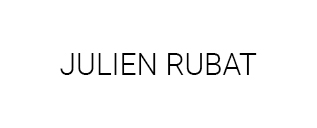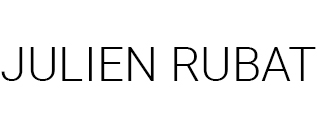
Julien Rubat (b. 1980, Chambéry, France) borrows techniques from printmaking and sculpture to create many-layered paintings that explore the intersection of chance and design. Following a rich international tradition in abstract painting that includes Hans Hartung, Clyfford Still and Mark Bradford, Rubat draws the viewer’s attention to the place of negative space within abstraction. His paintings are crafted using a unique mixed-media technique that sees him append and remove layers of paper until a balanced, almost topographical, composition emerges. He is celebrated for his systematic approach to painting, which allows organic-seeming patterns to emerge from a uniform process.
Born in Chambéry, France in 1980, Rubat transitioned from a career in technology into painting during a formative six-year period that he spent living in Los Angeles. He has since returned to the French Alps, where he lives and works today. His process involves layering tissue paper and paint onto a substrate, then transferring it to canvas in a method reminiscent of printmaking. Utilising tools of the artist’s own making, this physically intense process creates an almost sculptural surface where layers of paper adhere irregularly to the canvas, their exact configuration determined by a number of factors within and beyond the artist’s control.
Though non-representational, Rubat’s paintings often evoke natural formations such as cell structures and landscapes. Following the transferring process, he finishes each work by adding and removing layers in specific spots across the canvas. This process, guided by the artist’s intuition, brings a crucial element of intentionality to each painting. Conceptually, Rubat’s paintings are informed by his experiences with technology, forming a dialogue with rational thinking and rule-based processes on one side and the introduction of randomness on the other.
Rubat has been the subject of exhibitions around the world, in cities including Los Angeles, New York, Seoul, Paris and Madrid.
L’artiste français Julien Rubat développe une peinture où se croisent les techniques de la gravure et de la sculpture. En superposant et en retirant des couches de papier, il compose des surfaces denses et stratifiées qui interrogent l’équilibre entre hasard et construction. Inscrit dans une tradition internationale de l’abstraction, aux côtés de figures comme Hans Hartung, Clyfford Still ou Mark Bradford, il accorde une place essentielle à l’espace négatif et à la tension qu’il instaure dans la composition.
Né à Chambéry en 1980, Rubat a d’abord suivi une carrière dans le domaine technologique avant de se consacrer à la peinture lors d’un séjour décisif de six ans à Los Angeles. Il vit et travaille aujourd’hui dans les Alpes françaises. Son processus, exigeant physiquement, associe papier de soie et peinture sur un support qu’il transfère ensuite sur toile, selon une méthode proche de l’estampe. À l’aide d’outils qu’il fabrique lui-même, il obtient des surfaces presque sculpturales, où l’adhérence irrégulière du papier fait apparaître des configurations à la fois maîtrisées et imprévisibles.
Bien que non figuratives, ses peintures évoquent souvent des formations naturelles – paysages, structures organiques ou cellulaires. Après le transfert, Rubat intervient à nouveau sur la surface, ajoutant ou retirant des couches en des points précis. Ce travail d’ajustement, guidé par son intuition, apporte une dimension décisive d’intentionnalité à chaque toile. Nourrie par son expérience du monde technologique, sa recherche met en dialogue la logique des systèmes et la part de contingence propre au geste artistique.
Son œuvre a été présentée dans de nombreuses expositions à l’international, notamment à Los Angeles, New York, Séoul, Paris et Madrid.

